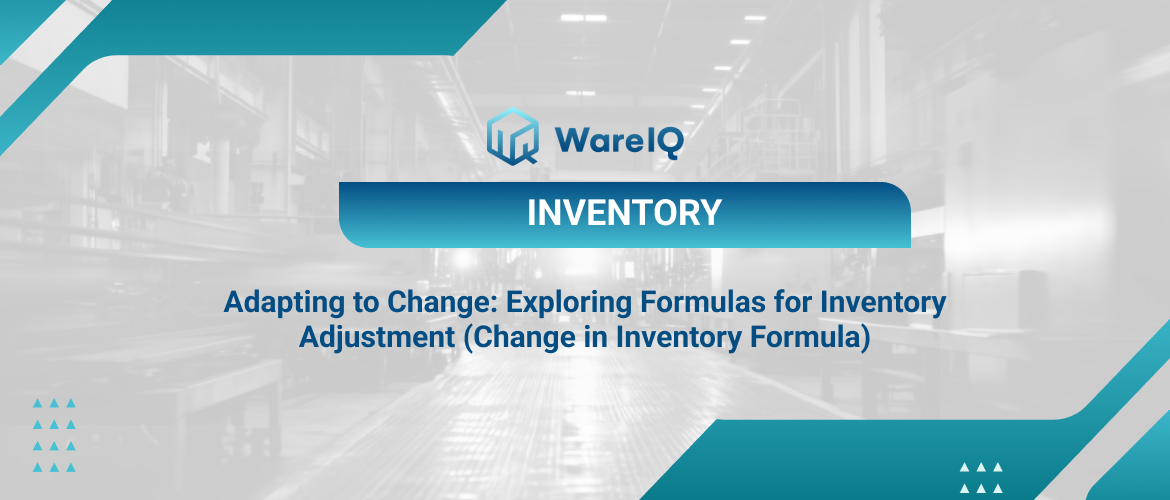Change in Inventory Formula: Exploring Formulas for Inventory Adjustment with Examples 2025

Adapting to change is paramount for success of business operations, particularly in managing inventory. As businesses upscale and market conditions fluctuate, the need for accurate inventory management becomes increasingly crucial. Exploring various formulas for inventory adjustment offers insights into optimising inventory levels. They are also known as change in inventory formula, which improve operational efficiency, and financial reporting accuracy. As the inventory in a business moves in and out, the change in inventory report ensures in-time deliveries and customer satisfaction.
In this exploration, we will look at the significance of adapting change in inventory formula to dynamic business environments. As such, they have a significant role in facilitating informed decision-making and uphold competitive edge amidst evolving market dynamics.
What is Change in Inventory Formula
Inventory adjustment ensures accurate stock records and prevents financial reporting errors. It involves:
- Physically counting inventory items.
- Comparing counts with recorded data.
- Identifying discrepancies and adjusting records.
- After management approval, updating financial records.
When management detects inventory overstatements or understatements, it’s crucial to adjust them promptly for accurate financial information and informed decision-making. That is what the Change in inventory formula is about. It calculates inventory adjustments after changes. It can be done using the Cost of Goods Sold (COGS) formula:
COGS = Starting Inventory + Purchases – Ending Inventory
Change in inventory formula allows real-time recording, preventing errors, enhancing efficiency, and improving supply chain management. However, frequent adjustments can be time-consuming and resource-intensive. Manual adjustments are prone to human error, risking inaccurate records and financial statements. Proactive inventory management with standardised procedures, regular audits, and robust controls is vital for accurate adjustments and effective stock management.

Change in Inventory Formula with Examples
The Change in inventory formula is the same as the Cost of Goods Sold (COGS) formula:
COGS = Beginning Inventory + Purchases – Ending Inventory
Managers use COGS to reflect inventory levels accurately, adjusting it to account for changes in stock items. It can also be simplified as:
Inventory Adjustment = Ending Inventory + Increase
Inventory Adjustment = Beginning Inventory – Decrease
Inventory Adjustment Example #1
A retail store had 1,200 units of a particular product in its starting inventory. During the month, they purchased an extra 800 units and sold 1,500 units of the same product. Calculate inventory adjustments before and after purchases.
Given:
Beginning Inventory: 1,200 units
Purchases: 800 units
Sales: 1,500 units
Applying Change in inventory formula,
Change in Inventory -= Beginning Inventory + Purchases – Sales
= 1,200 + 800 – 1,500
= 2,000 – 1,500
= 500 units
Therefore, the Change in inventory is 500 units.
Inventory Adjustment Example #2
A manufacturing company had an initial inventory of 5,000 units of raw material. During the month, they made additional purchases of 3,000 units. However, due to production requirements, they consumed 6,500 units of the same raw material. Calculate the adjusted inventory level.
Given:
Beginning Inventory: 5,000 units
Purchases: 3,000 units
Consumption (Cost of Goods Sold): 6,500 units
Using the Change in inventory formula,
Change in inventory Level = Beginning Inventory + Purchases- Consumption
= 5,000 + 3,000 – 6,500
= 8,000 – 6,500
= 1,500 units
The Change in inventory level of the raw material is 1500 units.
Inventory Adjustment Reasons
- Damage: Correcting quantities for damaged items ensures proper inventory valuation. Perishable goods like food, beverages, or chemicals can spoil or expire, requiring inventory adjustment.
- Expiry: Adjustments remove expired products from records.
- Scrap or waste: During manufacturing processes, some materials may become scrap or waste, leading to inventory reduction.
- Theft: Accounting for losses due to theft or shrinkage maintains accurate inventory levels.
- Inaccurate Recording: Rectifying mistakes in recording, like data entry errors, is necessary.
- Quality control issues: Products that fail quality checks or do not meet standards need to be removed from inventory.
- Supplier discrepancies: Differences between the quantity ordered and received from suppliers require Adjustment.
- Promotions: Adjusting inventory during promotions ensures sufficient stock.
- Returns: Promptly accounting for sales and purchase returns avoids incorrect stock levels.
- Obsolete Items: Removing obsolete products reflects their reduced value.
- Transfers: Modifying inventory levels when transferring stocks ensures accuracy.
- Changes in inventory valuation methods: Switching inventory valuation methods, such as FIFO or weighted average cost, can require adjusting inventory.
- Physical Inventory Practices: The timing and methods for full physical counts can affect inventory adjustment needs.
- Regulatory requirements: Changes in laws, regulations, or industry standards may cause inventory adjustments.
- Unexpected Production Issues: Actual production output can differ from planned quantities, necessitating inventory adjustment.
Benefits of Inventory Adjustments
Better Inventory Management
Accurate inventory data allows for better inventory planning, forecasting, and decision-making. Businesses can optimise stock levels, avoiding stockouts and stockpiling, and thus improve inventory turnover.
Cost Reductions
Adjusting inventory cuts losses. It also lowers costs from carrying too much or unsellable inventory.
Improved Customer Satisfaction
Maintaining accurate inventory levels helps companies. It ensures product availability and helps them better meet customer demand, which leads to better customer satisfaction.
Compliance and Auditing
Regular inventory adjustments help companies comply with accounting standards. They also help with tax rules and industry-specific requirements. These rules are about inventory management and financial reporting.
Operational Efficiency
Accurate inventory data makes operations smoother. It helps with planning production, buying, and managing warehouses.
Identifying Issues
Businesses can find issues like theft, mishandling, or process inefficiencies. These issues cause inventory discrepancies, cautioning companies to take remedies.
Tax Implications
Adjusting inventory levels can impact tax calculations. It ensures that businesses pay the right amount of taxes on their inventory.
Best Practices in Inventory Adjustment
- Make occasional counts during the period to catch inventory inconsistencies as they occur.
- Use software applications to simplify organising, balancing, and entering inventory adjustments.
- Communicate inventory level changes to other parts of the company to manage inventory effectively.
- Recognize mistakes and learn from them to prevent future issues.
Related read: Absorption Costing in E-commerce
Conclusion
In conclusion, embracing adaptable change in inventory formulas is pivotal in navigating the complexities of modern business landscapes. Different scenarios require appropriate application of the formula to arrive at the net inventory at any point of time. By staying agile and responsive to change, businesses can optimise inventory management practices and sustain long-term success.
Suggested read: Learn Reorder Quantity Formula
FAQs
What is the change in the inventory formula in P&L?
The change in inventory formula for Profit and Loss statement is:
Beginning Inventory+Purchases-Cost of Goods Sold=Ending Inventory
This formula is used to measure the ending inventory.
What is the change in inventory formula cash flow?
The change in inventory formula for cash flow is:
Beginning Inventory-Ending Inventory+Cost of Goods Sold.
Apart from starting and ending inventory, the cost of goods sold is also needed to use this formula.
What is a change in inventory costing?
Change in inventory costing refers to the change in the monetary value of inventory levels. It happens between accounting periods, due to swings in the cost of materials, labour, or overhead. It impacts the cost of goods sold and gross profit calculations for the period.
What does it mean when change in inventory is negative?
If there is a negative change in inventory at the end of the period, it means the ending inventory surpasses the beginning inventory. There’s more stock remaining at the end compared to its start.
What is inventory change statement?
An “inventory change statement” (also sometimes called an “inventory adjustment statement”) is a report that shows the difference between a company’s beginning and ending inventory levels over a specific period, like a quarter or a year. It’s a way to track how much inventory the company has gained or lost during that time.
How to calculate change in inventory?
To calculate the change in inventory, subtract the beginning inventory from the ending inventory. In simpler terms, it’s the difference between the value of inventory at the end of a period and the value at the beginning of that period.
What is negative finished goods inventory?
Negative finished goods inventory means your inventory records indicate you have less than zero of a particular finished product.








